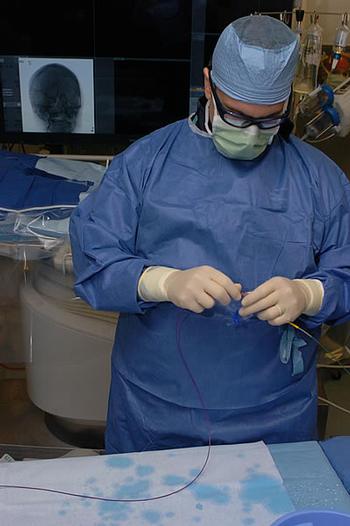Grant aids research into brain aneurysm treatment
A research grant is helping an East Carolina University neurosurgeon study ways to better treat people with ruptured brain aneurysms.
Dr. Robert James, an assistant professor of surgery at the Brody School of Medicine at ECU, is studying the use of intravenous low-dose heparin to treat people whose cerebral aneurysms have ruptured.

Dr. Robert James prepares to do a brain procedure Tuesday at Vidant Medical Center. Photo by Doug Boyd
To aid his research, James has received the 2012 Robert Simon Chair of Research, a $15,000 grant from the Brain Aneurysm Foundation. He is one of 10 researchers across the country to receive a total of $200,000 in grants this year from the foundation. The grants fund research aimed at early detection, improved treatments and technological advances that will ultimately improve outcomes for patients with brain aneurysms.
He is collaborating on the study with Dr. Erik Everhart, a professor of psychology at ECU.
A cerebral aneurysm is when an artery in the brain becomes weak and expands. By itself, it produces few if any symptoms. But if it bursts, it can lead to permanent disability or death.
The study will evaluate 50 patients of aneurysmal subarachnoid hemorrhage, a form of stroke; 25 will be treated with a prophylactic 14-day infusion of low-dose intravenous heparin, and the rest will receive a placebo infusion of normal saline. Afterward, James and Everhart will evaluate the patients’ neurocognitive function.
The drug heparin is commonly used as an anti-coagulation treatment in patients but has also been shown to have numerous other biological effects, such as reducing damaging inflammatory responses and endothelin-mediated cerebral vasospasm – a condition in which blood vessels restrict the flow of blood.
It might seem counterintuitive that an anticoagulant could help people with ruptured blood vessels, but it’s these other effects that lead James to think heparin can help.
“We hypothesize that patients treated with a prophylactic infusion of low-dose heparin will help prevent the neurocognitive and neuropsychological deficits commonly seen in these patients and that the patients will not have a higher incidence of hemorrhagic complications,” James said.
Complications and deficits that can follow include brain damage, fatigue, mood disturbances, anxiety and frequent headaches. James hopes the data he generates will lead to a larger grant to conduct a multi-center clinical trial.
The grants will be awarded at the sixth annual Brain Aneurysm Foundation Research Grant Symposium on Thursday, Sept. 20, in St. Louis.
James’ research project is titled “Prophylactic Low-Dose Intravenous Heparin Infusion for Aneurysmal Subarachnoid Hemorrhage: A Double Blinded, Placebo Controlled, Randomized, Phase II Clinical Trial.”
James is director of cerebrovascular and neuroendovascular surgery and co-director of the neuroscience intensive care unit at Vidant Medical Center in Greenville. He is fellowship-trained in open cerebrovascular surgery and endovascular neurosurgery, two advanced brain surgery techniques. He has brought techniques such as endovascular coiling to aneurysm patients in eastern North Carolina, treating more than 200 patients since arriving in Greenville in 2009.
An estimated 6 million people in the United States have a brain aneurysm, according to BAF. Each year about 27,000 people in the United States will suffer a ruptured brain aneurysm. About 40 percent of the victims will die. Of those surviving, only a third will recover without disabilities.